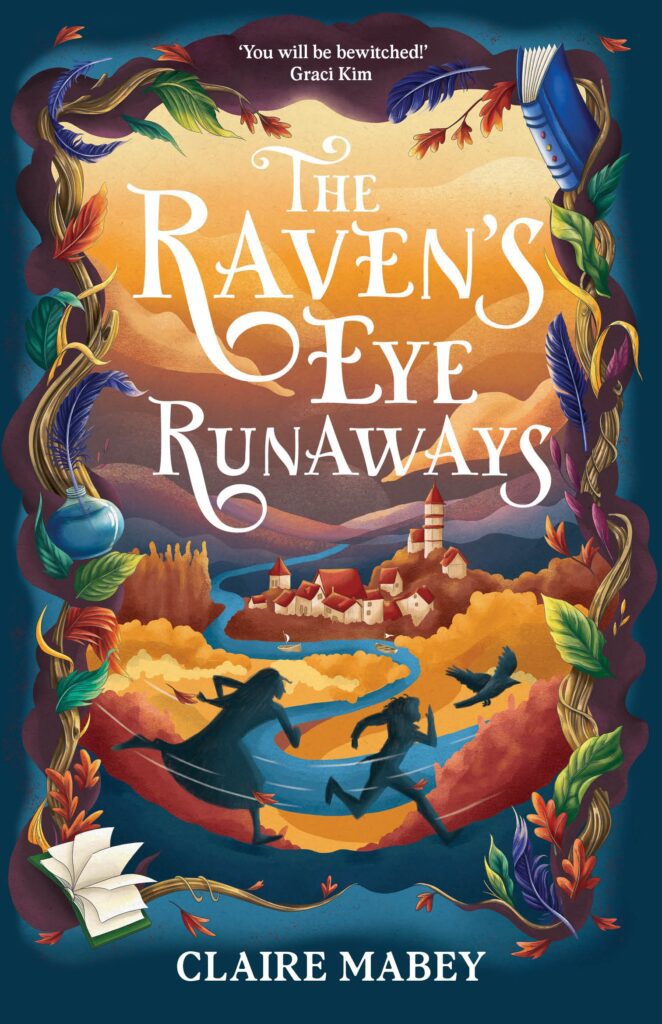The Raven’s Eye Runaways
The Raven’s Eye Runaways by Claire Mabey. Allen and Unwin (2024). RRP: $24.99. PB, 336pp. ISBN: 9781991006820. Reviewed by Laura Borrowdale.
The best children’s literature riffs on the literature that has come before it, and few forms are as codified as fantasy adventures. The echoes of pint-sized heroes and heroines and the monsters they have faced ripple through these books like a conversation through time. Claire Mabey’s first book, The Raven’s Eye Runaways, steps confidently into this ongoing exchange.
Getwin and her mother Gunnora are bookbinders in a world where books have huge value and yet reading is forbidden to all but the Scholars and Stationers of the world. When Gunnora goes missing while attending a library emergency, Getwin and her one-eyed raven, Sharp, must come up with a plan. As Getwin’s plan is set in motion, she meets Lea, a runaway scribe from a monastic, and sadistic, scriptorium, and together the two young women head out into the world, and up against forces bigger than themselves.
Mabey has distilled a number of classic tropes in The Raven Eye’s Runaways, a story in which plucky children and their animal sidekicks defeat and outwit malicious adults with nefarious purposes. The sly winks, overt nods and delicious similarities to all those children’s books that have gone before are part of the joy of reading. Here, the mediaeval European-ish location, the bold female leads, cantankerous birds, and even the mysterious baddies named the Stationers bring to mind Frances Hardinge’s Fly by Night, amongst others, and Mabey even fits in a hobbit-ish mention of second breakfast.
It’s no surprise that this is the first book from someone as deeply enmeshed in the literary world as Mabey. The greatest horror she can write is that of a world in which books are kept from readers. She describes books with such warmth and evident affection, not just as stories, but as objects themselves. The first magical book that the reader meets, Of the Ways and Methods of Bookbinding, makes a significant impression on Getwin: ‘It wasn’t just the quality of the binding that made the book so remarkable. It was the way it made Getwin feel. Warm, and floaty, like entering a dream. It was as though the book was alive and had a spirit that yearned to mingle with whoever was near it.’
However much the books in The Raven Eye’s Runaways are friend, they are also foe. The Stationers, a mostly unseen threat, use books to promote the hunting out of ‘strangeness’ or magic, and the malicious stories these books contain are ‘like a disease. They spread into the landscape. Into art, into heads. They turn into actions.’ And for Lea, the scribe, books are a source of horror, her life spent suppressed by Specialtea, endlessly, mindlessly, copying text. While Mabey has a warm and engaging style, she doesn’t talk down to children; doesn’t dumb down the vocabulary, or the horror. Girls write their hands to bloody stumps while tortured by women reminiscent of the aunts from Atwood’s The Handmaid’s Tale, mothers are tormented in the stocks, and life is cheap.
There is a lot to take in. The book moves rapidly through the world of the story, from bindery to boarding house, town centre to mystical forest glen, each replete with a cast of, at times hastily drawn, characters. For instance, Lea’s escape from the scriptorium is reliant on Marye, who, when asked to explain why at great peril she orchestrated the escape, can only respond: ‘“I don’t know,” she said at last. “Something told me I should, that’s all.”’ The occasional deus ex machina is buried in a whirling plot for younger readers.
It is exciting to see The Raven’s Eye Runways as part of what feels like a renaissance of middle grade fiction in New Zealand. TK Roxborogh, Rachael King and Ataria Sharman, amongst many others, are exploring what makes a compelling adventure story for younger readers, and in our current literacy crisis, it can’t come soon enough. The first magical book Getwin’s mother shows her seems to call out to its readers, mother and daughter alike. ‘Read me, read me, read me, pulsed the book.’ Given the speed my 12 year old gathered it up, The Raven’s Eye Runaways is also calling to readers: read me, read me, read me.
Laura Borrowdale is a writer and educator from Ōtautahi Christchurch. She regularly reviews for the Otago Daily Times, and her short fiction is widely published. Her first collection of short stories, Sex, with Animals came out with Dead Bird Books in 2020.
